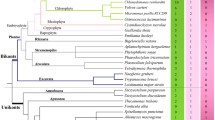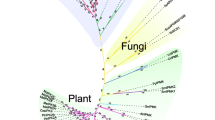Abstract.
About thirty years after the initial identification of 14-3-3 proteins in mammalian brain, they are now thought to be ubiquitous among eukaryotes. We identified five cDNAs encoding 14-3-3 proteins of Nicotiana tabacum L. using a polymerase chain reaction (PCR)-based screening strategy. A phylogenetic analysis was carried out with 14-3-3 amino-acid sequences from twelve plant species. The results showed that 14-3-3 proteins of plants can be divided into at least five different subgroups. Four of these subgroups resulted from early gene duplication events that happened prior to the speciation of most of the plant species considered. Interestingly, 14-3-3 epsilon isoforms from mammals and insects form one subgroup together with epsilon-like isoforms from plants. The 14-3-3 genes known from monocots descend from the same ancestor, forming the fifth subgroup.
Similar content being viewed by others
Author information
Authors and Affiliations
Additional information
Received: 30 June 1997 / Accepted: 29 August 1997
Rights and permissions
About this article
Cite this article
Piotrowski, M., Oecking, C. Five new 14-3-3 isoforms from Nicotiana tabacum L.: implications for the phylogeny of plant 14-3-3 proteins. Planta 204, 127–130 (1997). https://doi.org/10.1007/s004250050238
Issue Date:
DOI: https://doi.org/10.1007/s004250050238




